Keywords
|
| Electric vehicle, grid integration, V2G & G2V, quality power |
INTRODUCTION
|
| The history of electric vehicle starts in 1868. Since then, studies were going on in utilizing EV as future Vehicle. EV charging station is the place where an EV integrates with the distribution grid. So, expert care has to be given in designing the components in the charging station to ensure a quality grid integration. Also, since the EV has to be user friendly, we have to reduce the charging time. Therefore, the work has been done for a Level 3(200/600V DC, up to 240kW, 400A) [1] EV charging station which ensures fast DC charging. |
| The integration of EV the grid offers a lot of challenges in power quality. The design of different elements in the proposed model is precisely done to aid quality power exchange. The AC-DC converter employs a control in dq reference frame. The DC-DC converter which aids the EV battery charging/discharging employs constant voltage/ constant current strategy. The control strategies tries to fulfill recent IEEE standards 1459-2010 with the objective of maximizing the use/injection of AC power from/into the grid reducing the lower order harmonic factor. In the proposed paper, different aspects of EV integration to grid are analyzed and the results are shown. |
EV CHARGING STATION DESIGN
|
| The configuration of proposed DC charging station is shown below in Fig 1. The converter is connected to the grid through a LCL filter and transformer. EVs are connected to the slots provided in the DC bus. |
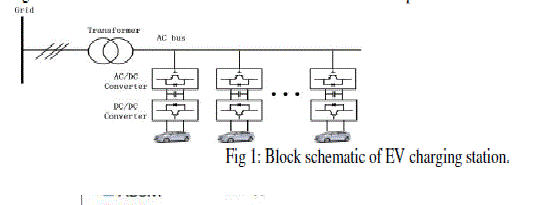 |
| The charging station rated capacity can be calculated from the below equation. |
 |
| The charging station rated capacity depends upon the overload factor (Kload), number of slots provided (Nslot), maximum power of individual EV (PEV), and the power factor (cosØ). |
| The upper limit of DC bus nominal voltage is calculated by considering the minimum battery voltage Vbat min and the battery charger minimum modulation index mmin. |
 |
A. DC Bus Capacior
|
| The size of the DC capacitor determines the stability of the DC bus. Since many EVs are connected to the DC bus in the same time, the ripple currents will be very high; thus need a DC bus capacitor. The value can be calculated from the following equation [2]. |
 |
| The value of the DC bus capacitor depends upon the time period (T) of the AC voltage waveform and allowable DC power (Δr) & bus voltage (Δx) expressed in percentage. |
B. Electric Vehicle Battery Selection
|
| The most commonly used EV battery is Li-ion battery. However Nickel Cadmium batteries are also in use. There are some specifications to be considered while selecting the EV battery. They are nominal voltage, cut-off voltage, energy or nominal energy, ampere hour capacity, life of battery, specific energy, specific power, energy density, charge/discharge cycles of battery, internal resistance, environmental factors etc. |
C. Electric Vehicle Battery Charger Unit
|
| Below Fig 2 shows the battery charger unit. A buck-boost battery charger [3] unit is considered. |
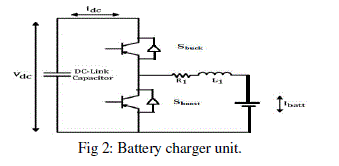 |
| The unit consists of two IGBT switches which performs buck and boost mode of operation under the required control strategy. This unit serves as a DC-DC converter. While boost mode (charging) of operation is executing, the corresponding thyristor switch will be active and the other remains idle and vice versa. |
D. Three Phase Converter
|
| The power exchange between AC grid and the DC converter is controlled by the AC-DC converter. It is a bidirectional converter. The switches are IGBTs with gate pulses fed to them to control its operation. Fig 3 shows such an arrangement. The converter is connected to a filter unit. |
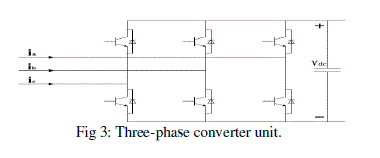 |
E. LCL Filter
|
| Filters are essential to cut out the harmonics in the system. The Fig 4 shows the filter configurations [4] which consist of converter side inductor (Lcon), filter capacitor (Cf) and grid side inductor (Lgrid). |
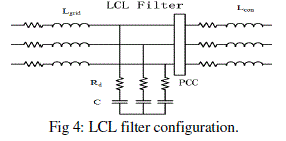 |
| The design equations [2] for obtaining the values are as follows. |
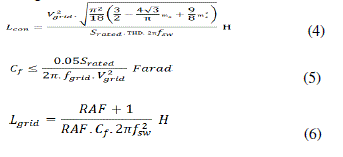 |
| The value of inductor and capacitor depends upon the switching frequency (fSW) of the converter, grid frequency (fgrid), modulation index (ma) of the converter, allowable THD range and ripple attenuation factor (RAF) for respective design equations. |
| Since there are undamped power oscillations, a damping resistor [6] is included in the circuit to damp out the power oscillations. It can be calculated by the following equation. |
 |
| Where, ωres is given by, |
 |
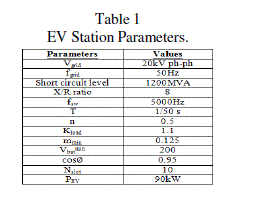 |
CONTROLS USED
|
| The control system deals with the control of AC-DC converter and the DC-DC converter. The control system provides a smooth transition from the G2V mode to V2G mode, and simultaneous EV charging and discharging. Converter control |
| Control in dq reference frame [5], [7] shown in Fig 5 is used to control the converter operation [10]. It consists of voltage and current loops connected in cascade structure. The controller controls the DC bus voltage, alternating current, and the real & reactive power. |
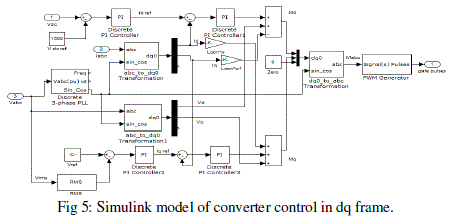 |
| The terms ωLcon and feed forward voltage are given to handle well with transient conditions. Grid synchronization is made possible [8], [9] using a PLL block shown in below Fig 6. Measured three-phase voltage is given as the input to the PLL block. |
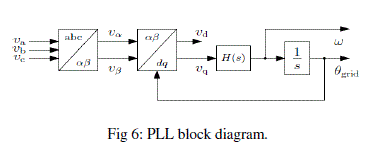 |
| A. EV Battery ChargerUnit |
| Separate control strategies are implemented to control the charging and discharging of the EV battery. The Simulink model for the battery charger circuit is shown below. Since we are considering an off-board DC battery charger unit, the EV battery is directly plugged to the charger circuit as shown in the fig 7. |
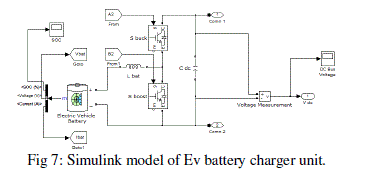 |
| 1) Constant Current (CC) Strategy |
| In CC strategy, the battery operates as a constant current source. The converter will operate in boost mode (discharging process). |
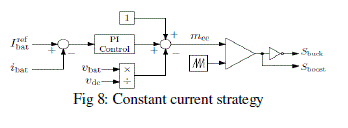 |
| 2) Constant Voltage (CV) Strategy |
| In CV strategy, the battery charges under a constant voltage source. The converter will operate in buck mode (charging process). |
 |
SIMULATION RESULTS
|
| As per the design procedure explained earlier, the Simulink model is implemented in Matlab. The various component blocks used in Simulink modeling is obtained from the SimPower System Library. |
| A. EV Charging Mode (G2V operation) |
| Fig 10 shows the simulink model for the EV charging mode. The EV battery charging is controlled in constant voltage strategy. |
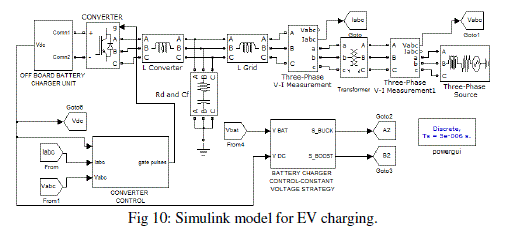 |
| The results obtained after running the simulation are shown below. |
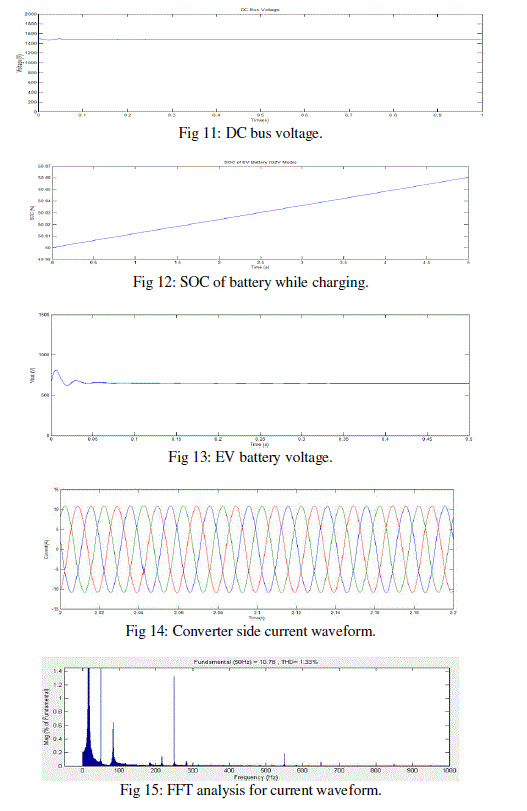 |
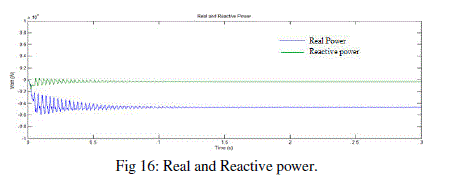 |
| B. EV Discharging Mode (V2G operation) |
| Fig 18 shows the Simulink model for the EV discharging mode. The EV battery discharging is controlled in constant current strategy. Also, the feasibility of operating EV as a grid connected distributed generation is illustrated in the results shown below. The EV battery discharging is controlled by constant current control strategy. |
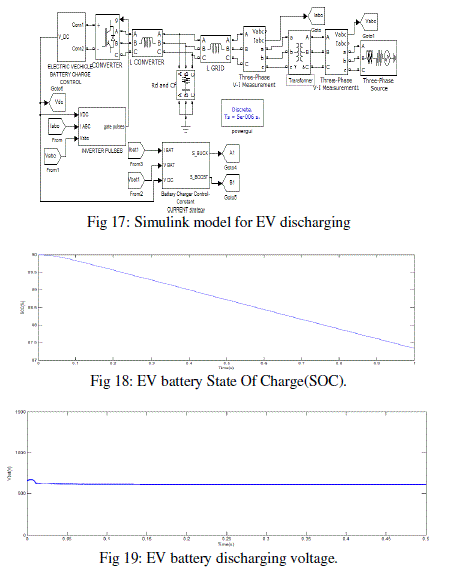 |
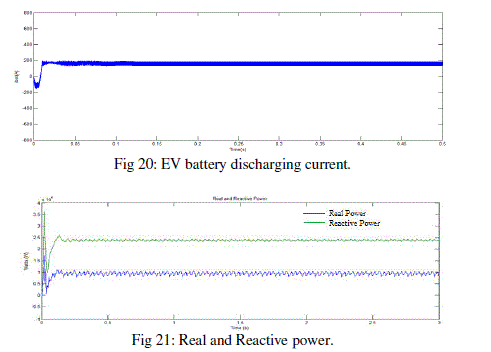 |
| C. Simultaneous EV Charging and Discharging Mode. |
| Below Fig 22 shows the simulink model for the grid connected EVs operating both in charging and discharging mode. The EVs are plugged into the respective slots provided for charging/discharging. This scheme of operation enables the V2G and G2V mode at the same time. |
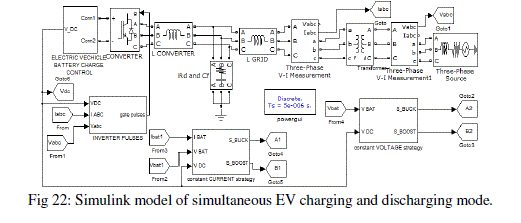 |
| The results below show the balanced operation of the proposed scheme. |
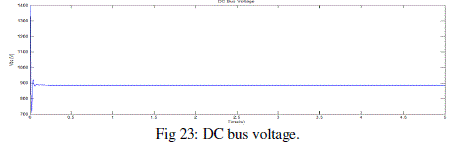 |
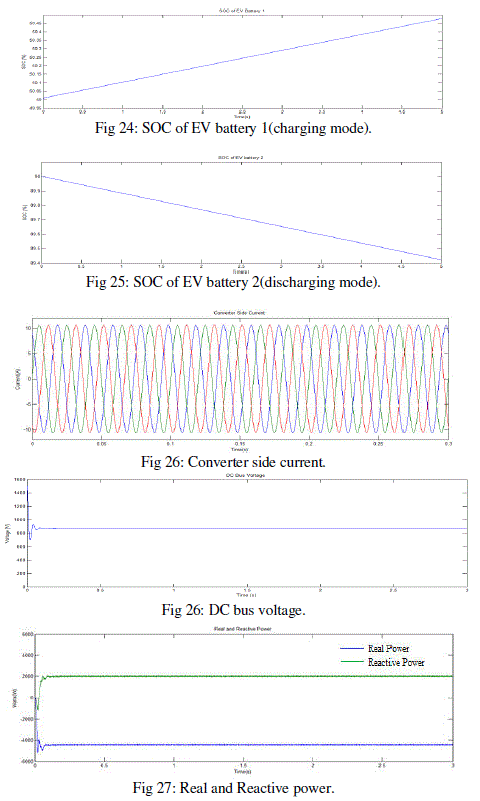 |
CONCLUSION
|
| A new model for integrating EV to the distribution grid assuring the quality power has been proposed. The modeling equation of each element and the implementation in Matlab/Simulink model is also explained. The feasibility of EV charging mode is illustrated with the help of simulation results. Investigation of using EV as a distributed generation is also done and is shown in results. The results compromise with the IEEE standards 1459-2010 with the objective of maximizing the use/injection of AC power from/into the grid reducing the lower order harmonic factor and load unbalance. |
| |
References
|
- http://www.sae.org/smartgrid/chargingspeeds.pdf.Arancibia A., Strunz K., "Modeling of electric vehicle charging station for fast DC charging"Electric Vehicle Conference (IEVC), 2012 IEEE International.Karlsson P. Svensson J., "DC bus voltage control for distributed power systems",Power Electronics, IEEE Transaction on Vol.18, no.6, pp. 1405-1412, nov 2003.
- Mohan N. "First course on Power Electronic converters and Drives" Minneapolis, USA. ISBN 0-9715292-2-1
- Min-Young Park, Min-Hun Chi, Jong-Hyoung Park, Heung-Geun Kim, "LCL filter for grid connected PCS using total harmonic distortion an ripple attenuation factor" Power Electronics conference (IPEC), 2010 International, vol no., pp.1688-1694, 21-24June 2010.
- Yazdani, A. Iravani R., "Voltage sourced converters in Power System modeling, control and application"John Willey and sons, 2009-Technology and Engineering.
- Wessels C., Dannehl J, and Fuchs F.W., Äctive damping of LCL filter resonance based on virtual resistor for PWM rectifiers - stability analysiswith different filter parameters" in Power Electronics Specialist Conference, 2008.p. C.D.
- Gabe, I. J., Montagner, V. F., and Pinheiro, H., “Design and implementation of a robust current controller for vsi connected to the gridthroughanlcl filter,” Power Electronics, IEEE Transactions on, vol. 24, no. 6,pp. 1444–1452, June 2009.
- A. V. Timbus,M. Liserre, R. Teodorescu, and F. Blaabjerg, “Synchronization methods for three phase distributed power generation systems. Anoverview and evaluation,” in Proc. IEEE PESC, 2005, pp. 2474–2481.
- M. C. Benhabib and S. Saadate, “A new robust experimentally validated phase-looked loop for power electronic control,” EPE J., vol. 15, no.3, pp. 36–48, Aug. 2005.
- Mohan, N. Undeland, T. Robbins, W.”Power Electronics Converters, Applications, and Design” ISBN 0-471-22693-9.
|